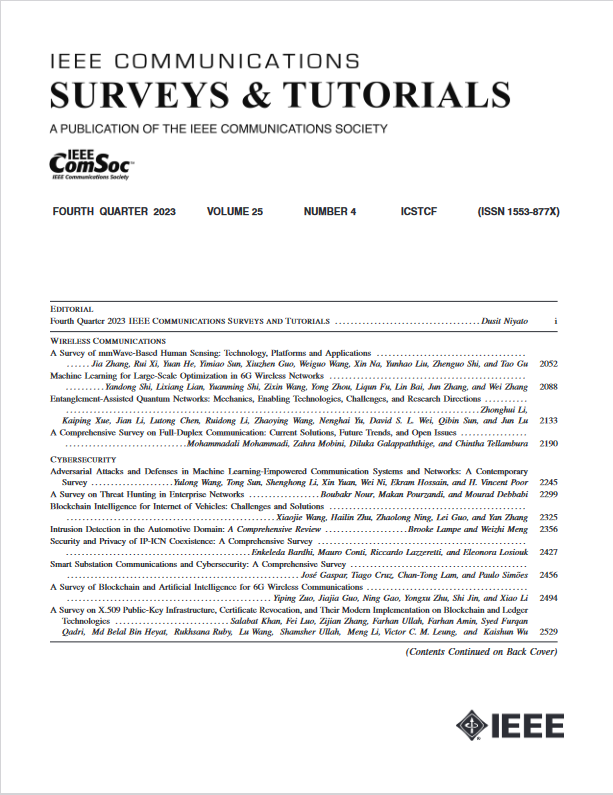Toward Addressing Training Data Scarcity Challenge in Emerging Radio Access Networks: A Survey and Framework
IF 34.4
1区 计算机科学
Q1 COMPUTER SCIENCE, INFORMATION SYSTEMS
引用次数: 3
Abstract
The future of cellular networks is contingent on artificial intelligence (AI) based automation, particularly for radio access network (RAN) operation, optimization, and troubleshooting. To achieve such zero-touch automation, a myriad of AI-based solutions are being proposed in literature to leverage AI for modeling and optimizing network behavior to achieve the zero-touch automation goal. However, to work reliably, AI based automation, requires a deluge of training data. Consequently, the success of the proposed AI solutions is limited by a fundamental challenge faced by cellular network research community: scarcity of the training data. In this paper, we present an extensive review of classic and emerging techniques to address this challenge. We first identify the common data types in RAN and their known use-cases. We then present a taxonomized survey of techniques used in literature to address training data scarcity for various data types. This is followed by a framework to address the training data scarcity. The proposed framework builds on available information and combination of techniques including interpolation, domain-knowledge based, generative adversarial neural networks, transfer learning, autoencoders, few-shot learning, simulators and testbeds. Potential new techniques to enrich scarce data in cellular networks are also proposed, such as by matrix completion theory, and domain knowledge-based techniques leveraging different types of network geometries and network parameters. In addition, an overview of state-of-the art simulators and testbeds is also presented to make readers aware of current and emerging platforms to access real data in order to overcome the data scarcity challenge. The extensive survey of training data scarcity addressing techniques combined with proposed framework to select a suitable technique for given type of data, can assist researchers and network operators in choosing the appropriate methods to overcome the data scarcity challenge in leveraging AI to radio access network automation.解决新兴无线接入网络中训练数据短缺的挑战:调查和框架
蜂窝网络的未来取决于基于人工智能(AI)的自动化,特别是无线电接入网(RAN)的操作、优化和故障排除。为了实现这种零接触自动化,文献中提出了无数基于人工智能的解决方案,以利用人工智能对网络行为进行建模和优化,从而实现零接触自动化目标。然而,要想可靠地工作,基于人工智能的自动化需要大量的训练数据。因此,所提出的人工智能解决方案的成功受到蜂窝网络研究界面临的一个根本挑战的限制:训练数据的稀缺。在本文中,我们对解决这一挑战的经典和新兴技术进行了广泛的回顾。我们首先确定RAN中常见的数据类型及其已知的用例。然后,我们对文献中用于解决各种数据类型的训练数据稀缺性的技术进行了分类调查。随后是一个解决培训数据短缺问题的框架。所提出的框架建立在可用信息和技术组合的基础上,包括插值、基于领域知识、生成对抗性神经网络、迁移学习、自动编码器、少镜头学习、模拟器和测试台。还提出了丰富蜂窝网络中稀缺数据的潜在新技术,例如通过矩阵完成理论,以及利用不同类型的网络几何形状和网络参数的基于领域的技术。此外,还概述了最先进的模拟器和试验台,以使读者了解当前和新兴的访问真实数据的平台,从而克服数据稀缺的挑战。对训练数据稀缺性解决技术的广泛调查,结合为给定类型的数据选择合适技术的拟议框架,可以帮助研究人员和网络运营商选择合适的方法,以克服利用人工智能实现无线电接入网络自动化的数据稀缺性挑战。
本文章由计算机程序翻译,如有差异,请以英文原文为准。
求助全文
约1分钟内获得全文
求助全文
来源期刊

IEEE Communications Surveys and Tutorials
COMPUTER SCIENCE, INFORMATION SYSTEMS-TELECOMMUNICATIONS
CiteScore
80.20
自引率
2.50%
发文量
84
审稿时长
6 months
期刊介绍:
IEEE Communications Surveys & Tutorials is an online journal published by the IEEE Communications Society for tutorials and surveys covering all aspects of the communications field. Telecommunications technology is progressing at a rapid pace, and the IEEE Communications Society is committed to providing researchers and other professionals the information and tools to stay abreast. IEEE Communications Surveys and Tutorials focuses on integrating and adding understanding to the existing literature on communications, putting results in context. Whether searching for in-depth information about a familiar area or an introduction into a new area, IEEE Communications Surveys & Tutorials aims to be the premier source of peer-reviewed, comprehensive tutorials and surveys, and pointers to further sources. IEEE Communications Surveys & Tutorials publishes only articles exclusively written for IEEE Communications Surveys & Tutorials and go through a rigorous review process before their publication in the quarterly issues.
A tutorial article in the IEEE Communications Surveys & Tutorials should be designed to help the reader to become familiar with and learn something specific about a chosen topic. In contrast, the term survey, as applied here, is defined to mean a survey of the literature. A survey article in IEEE Communications Surveys & Tutorials should provide a comprehensive review of developments in a selected area, covering its development from its inception to its current state and beyond, and illustrating its development through liberal citations from the literature. Both tutorials and surveys should be tutorial in nature and should be written in a style comprehensible to readers outside the specialty of the article.
 求助内容:
求助内容: 应助结果提醒方式:
应助结果提醒方式:


